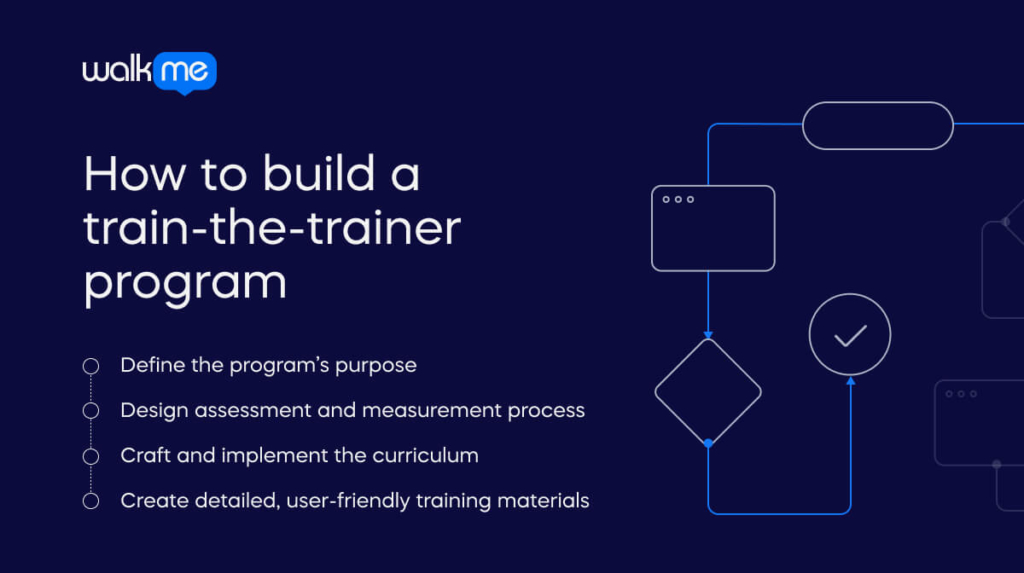Trainers need the best tuition to pass on the best skills.
You’ve come across the train-the-trainer model in action if you’ve seen one person learning something well and instructing others how to teach it.
A culture of employee training positively impacts employee retention. This culture can improve retention by 57%, saving resources on recruitment.
This article defines the train-the-trainer model and explains how programs work, how to choose participants, and how to build a program. By the end of the article, you’ll know the significance of this model and be able to train trainers well for a skilled, innovative workforce.
What is the train-the-trainer model?
The train-the-trainer model allows employees to receive teaching on how to be trainers. When trained employees become trainers, they can teach their colleagues skills and knowledge.
This approach is one of the most popular methods of training because it spreads knowledge quickly and consistently. You won’t need expensive outside experts who won’t understand your learning culture. Internal trainers save money and tailor training to employee needs.
They also help build a strong learning culture so employees learn in every task, understand their learning needs, and meet them via online training. This approach increases employee productivity as they work and learn.
The train-the-trainer model allows skills to influence more employees. One study suggests that a medical surgeon who treats 10,000 patients can extend their influence to 400,000 patients when the surgeon becomes a trainer. Apply this to enterprises, and you will extend ROI for training well beyond current limitations.
How do train-the-trainer programs work?
A train-the-trainer program involves teaching a few selected employees specific skills. This training allows them to teach those skills to their coworkers, making it a type of employee training for enterprise use.
Here’s how it works: First, the company chooses some of its best employees who are good at their jobs and also good at explaining things to others.
These employees receive the extra title of “trainers” and get special training sessions. During these sessions, they learn new skills and techniques and how to teach them effectively.
Once the trainers have completed their training, they return to their workplace and start teaching their coworkers. This method removes the need to bring in outside teachers for new skills, and the company now has its trained experts.
They can pass on their knowledge to colleagues. This process is much more efficient than using outside trainers. It allows many employees to learn quickly from someone they already know and trust.
The main benefits of these programs include saving time and money, ensuring everyone gets the same high-quality training, and building a strong, knowledgeable team within the company.
What are the goals of the train-the-trainer model?

Know this model’s goals to get the most out of it. You enjoy many benefits when you understand the ins and outs of training manuals, learner questions, practical activities, and alternative resources. If you hit these goals, you enhance internal training capabilities, enable consistent skill development, and accelerate organizational knowledge.
Offer information with training manuals
One important goal within a train-the-trainer program is to provide trainers with clear and detailed training manuals. These manuals are the go-to resource for all the information the trainers need to teach their colleagues.
They act as guides, ensuring every trainer covers the same important points. This approach means everyone in the organization receives consistent and accurate information, which helps them learn and apply new skills.
Answer learner questions
Another goal of the train-the-trainer model is to prepare trainers to answer learners’ questions. When employees learn something new, they often have questions or need help understanding certain parts.
The trainers must be able to explain things clearly and provide answers to these questions. This kind of communication helps the learners feel more confident in their understanding and ensures they can use the new skills effectively.
Promote practical activities
Promoting practical activities is crucial in train-the-trainer programs. Trainers should include hands-on exercises during their teaching sessions. These activities allow learners to practice what they’ve learned in real-life scenarios. Learners gain experience and confidence in using their new skills, making it easier for them to apply them in their daily work.
Show learners other resources
A key goal is to show learners where they can find additional resources. Trainers guide employees to other helpful materials, such as books, websites, or videos. All of these resources can deepen their understanding.
When trainers show learners other resources, they ensure they have access to all the necessary tools. They can then continue learning and improving, even after the training session.
How to choose the right participants for a train-the-trainer program?
Choosing the right participants for a train-the-trainer program is important because these people will be responsible for teaching others in the company. They need to have certain qualities to ensure the training is successful.
Here’s how to choose the right participants:
- Subject experience: Select participants with solid knowledge and expertise in their teaching subject. These criteria ensure they can effectively explain the material and answer any questions.
- Great communication skills: Choose participants who are good at explaining things clearly and simply. They should make complicated topics easy for others to understand.
- Teaching passion: Pick people who are enthusiastic about helping others learn. Participants should genuinely want to teach and share their knowledge with their colleagues.
- Patience and empathy: The right participants should be patient and understanding. They need to be able to support learners who might struggle with new information.
- Respect from colleagues: Select participants whose peers respect them. Learners who respect their trainers are likelier to pay attention and learn effectively.
These qualities help ensure the effectiveness of the train-the-trainer program and the successful passing of knowledge by trainers.
How to build a train-the-trainer program

Knowing how to build a train-the-trainer program is essential. It ensures that your candidates who will become trainers enjoy structured learning and that the best ways to learn and teach are role-modeled so they can learn these skills and pass them on to colleagues who may want to become trainers.
Define the program’s purpose
The first step is to clearly define the purpose of the train-the-trainer program. This step involves understanding why the program is needed and including the specific goals it aims to achieve.
For example, the purpose might be to improve employee skills in a particular area, like using new software or following safety procedures. By defining the purpose, you ensure that everyone involved understands the program’s goals and stays focused on what’s important.
Design assessment and measurement process
Next, you need to design a process for assessing and measuring how well the program is working.
Set up ways to test the trainers’ knowledge and skills before and after training. You must also figure out how to measure the success of the training they deliver to others.
For example, you could use quizzes, surveys, or practical tests to see if the trainers and learners achieve the program’s goals.
These tests help ensure the training is effective and everyone learns what they need.
Craft and implement the curriculum
After that, you need to craft the curriculum, which provides the structure for your teaching. This process includes deciding what topics the curriculum will cover, how you will present the information, and what learning methods you will use.
So, the curriculum exists; now what? Next, it’s crucial to implement it by conducting training sessions where the selected trainers will learn this material. The curriculum should be clear and organized, easy for trainers to follow, and effective for teaching others.
Create detailed, user-friendly training materials
The final stage is to create the training materials for the sessions.
These materials can include things like:
- Manuals: These offer detailed points of reference for various topics.
- Slides: Many learners love slides because of their visual learning style.
- Videos: Videos are an engaging way to help learners absorb information.
- Worksheets: Worksheets are a great way to practice learning through doing.
Trainers will use these materials to teach others. They should be detailed and user-friendly so trainers can easily understand and explain the content. Suitable training materials help ensure that everyone receives the same high-quality instruction and can refer to these resources whenever they need help.
Follow these stages to offer your learners an engaging, structured curriculum. This approach will help them become the best trainers and inspire them to structure their training.
Use the train-the-trainer model for organizational development
The train-the-trainer model has a far-reaching impact, so it’s important to understand every aspect of it. Ensure you fully engage with what it is, goals, and how to build a program before investing time and money.
This model allows individuals to have a significant impact on their organizational development.
To enhance organizational development using the train-the-trainer model, train a few experienced employees to teach important skills to others.
This approach spreads knowledge efficiently across the company, improving everyone’s abilities and helping the organization grow stronger and more successful.
The benefits are a skilled workforce and a learning culture in which each employee seeks to innovate, help their company grow, and increase revenue.
FAQS
How do you structure a train-the-trainer program?
Structure your train-the-trainer using these elements:
- Define the purpose: Decide why learners need the training and what skills they need.
- Choose trainers: Select employees with solid knowledge, communication skills, and a passion for learning.
- Develop a curriculum: Create a clear and organized plan of what will be taught.
- Build training materials: Prepare manuals, slides, and other resources for trainers.
- Assess success: Test trainers and learners to ensure the program is effective.
What should a train-the-trainer model include?
Every successful train-the-trainer model should include these elements:
- Selection of trainers: Choose employees who are experts and good at teaching.
- Training sessions: Teach these trainers both the content and how to train others.
- Training materials: Provide trainers manuals, guides, and other tools.
- Support system: Ensure trainers have access to resources and help if needed.
- Evaluation: Assess how well trainers are teaching and how well learners are understanding.
What is an example of a train-the-trainer model?
Imagine a company introducing a new software system. Instead of hiring someone from outside, they train a few employees to become experts in using the software. These trained employees then teach the rest of the team how to use it, ensuring everyone knows how to do their jobs better.


